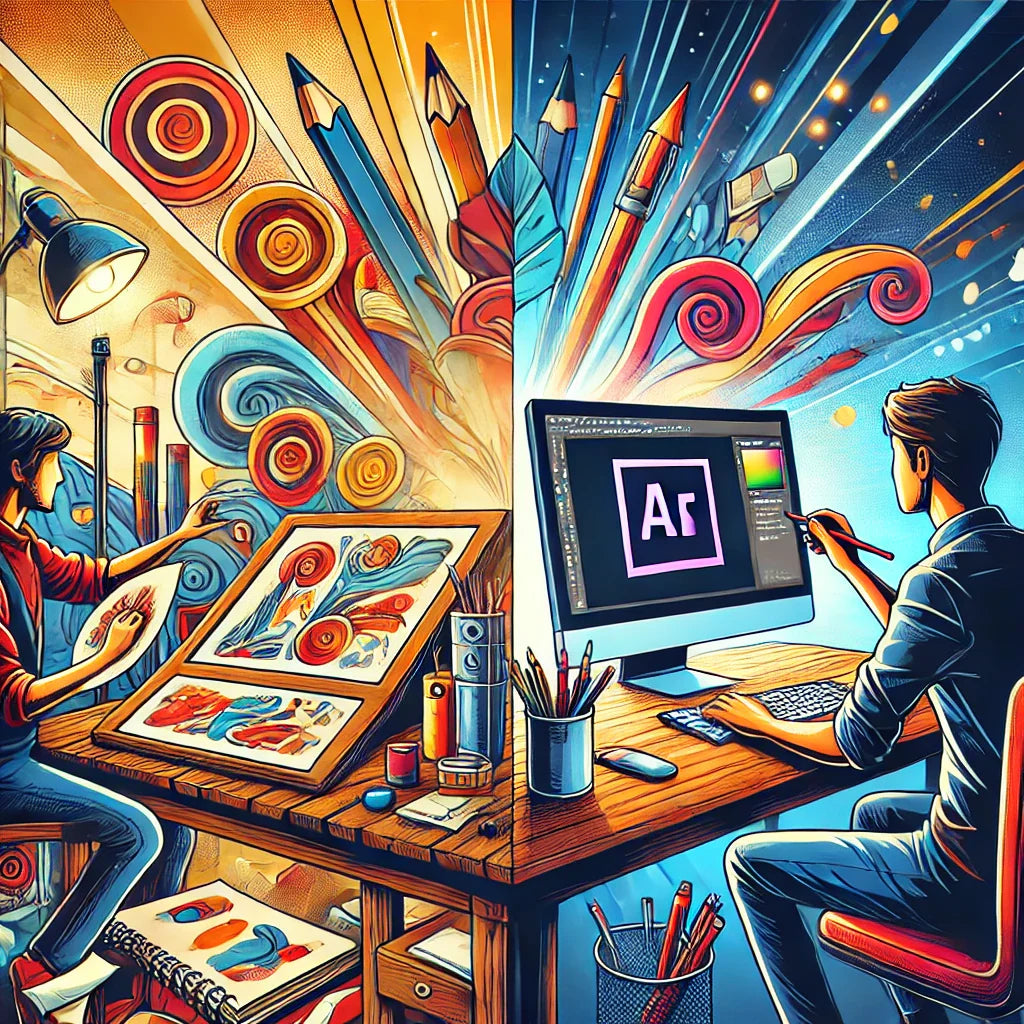
Learn How to Use Adobe Illustrator: A Guide for Artists Transitioning from Traditional to Digital
Share
Learn How to Use Adobe Illustrator: A Guide for Artists Transitioning from Traditional to Digital
Making the leap from traditional art to digital design can feel like moving to a new planet. Brushes become vectors, paper becomes artboards, and your trusty eraser? Well, it's now an "undo" shortcut! If you're an artist ready to step into the digital world, this guide will help you learn how to use Adobe Illustrator—a powerhouse tool that's the gold standard for digital artists.
Why Adobe Illustrator is Perfect for Artists Transitioning to Digital
Adobe Illustrator isn't just another software; it's a game-changer for artists. Unlike raster-based tools like Photoshop, Illustrator uses vector graphics, which means your artwork can be resized infinitely without losing quality. This is especially handy for creating logos, illustrations, and print-ready designs. Plus, it mimics many of the techniques you're already familiar with in traditional art—just with a digital twist.
First Steps to Learn Adobe Illustrator
1. Set Up Your Workspace
Before diving in, familiarize yourself with Illustrator's interface. Open the software, and you'll be greeted by panels, toolbars, and a blank artboard. To ease the transition, you can customize your workspace to mimic your traditional setup. For example, group your essential tools like the pen tool, brushes, and layers for easy access.
2. Master the Pen Tool
If there's one tool you need to conquer, it's the pen tool. It’s the bread and butter of vector art. Think of it as your new pencil—it’s a bit tricky at first, but once you’ve got the hang of creating anchor points and curves, the possibilities are endless.
3. Experiment with Brushes
Did you know Illustrator has a brushes panel that lets you draw with customizable strokes? From calligraphy to scatter brushes, you can replicate the feel of traditional painting right on your screen. For extra flair, you can even create your own custom brushes.
Key Features Every Artist Should Know
Layers Panel
Just like stacking paper or transparencies in traditional art, the layers panel lets you organize your work. Use layers to separate background elements, sketches, and final linework. This keeps your project manageable and editable.
Pathfinder Tool
Combining shapes is a breeze with the Pathfinder tool. Think of it as your scissors and glue. Whether you’re merging two circles to create a complex design or cutting out shapes, this tool will become your go-to.
Color Guides and Gradients
Illustrator's color tools are a dream for any artist. Use the color guide to find complementary shades, or play with gradients to add depth and dimension to your work. You can even import swatches to match your traditional palette.
Tips for a Smooth Transition
Start Simple
Your first project doesn’t have to be a masterpiece. Start with basic shapes, like turning a hand-drawn sketch into a clean vector illustration. Over time, you can incorporate advanced techniques like gradients, masks, and typography.
Take Advantage of Templates
Illustrator comes with pre-made templates for posters, business cards, and more. These can save you time and give you a head start on your projects.
Embrace Mistakes
Remember when you first learned how to use charcoal or watercolors? It wasn’t perfect right away, but you improved with practice. Digital art is no different. Explore, experiment, and don’t be afraid to hit “undo” a few hundred times.
Why Professor Patrick’s Adobe Illustrator Boot Camp is a Must-Have
Ready to fast-track your learning? Professor Patrick—Illustrator, Instructor, and self-proclaimed Jedi Master—has the ultimate course to help you master Adobe Illustrator. This comprehensive boot camp is tailored for artists transitioning to digital, and it's packed with insider tips, project-based lessons, and step-by-step guidance.
Here’s why you can’t miss this:
-
Proven Techniques: Learn from an experienced professional with years of expertise.
-
Project-Based Learning: Create real-world designs while mastering key tools.
-
Lifetime Access: Revisit the material whenever you need a refresher.
-
Limited-Time Sale: The course is currently discounted, but not for long! Don’t miss your chance to save big.
You’re not just buying a course; you’re investing in your artistic future. Get started here: Professor Patrick’s Adobe Illustrator Boot Camp.
Conclusion: Your Digital Adventure Awaits
Learning how to use Adobe Illustrator is like opening the door to a whole new world of artistic possibilities. It’s not about leaving traditional art behind—it’s about expanding your skillset and expressing your creativity in new ways. With practice, patience, and the right guidance, you'll be creating digital masterpieces in no time.
Ready to take the leap? Start exploring, start experimenting, and don't forget to check out Professor Patrick’s Boot Camp while it’s still on sale. Your journey to becoming a digital art Jedi starts today!
FAQs
1. Is Adobe Illustrator hard to learn for beginners? Not at all! While it has a learning curve, resources like Professor Patrick’s Boot Camp make it easy to pick up the basics and gain confidence quickly.
2. Do I need a drawing tablet to use Adobe Illustrator? A drawing tablet can enhance your experience, but it’s not required. A mouse or trackpad works perfectly fine for most tasks.
3. Can I use Adobe Illustrator on an iPad? Yes! Adobe Illustrator has an iPad version, offering a streamlined experience for on-the-go creativity.
4. How long does it take to become proficient in Adobe Illustrator? It depends on your dedication. With consistent practice and resources like the Boot Camp, you can become proficient in a few weeks.
5. Why choose Adobe Illustrator over other design software? Illustrator’s vector-based tools make it ideal for creating scalable, professional-quality designs. It’s the industry standard for a reason!
#illustrator #adobeillustrator #learnillustrator #digitalart #vectorart #digitalillustration #arttutorials #learnadobeillustrator #professorpatrick #patrickscullin
